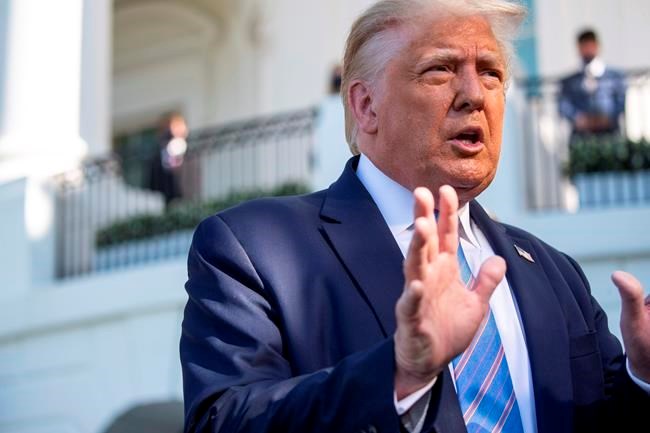WASHINGTON — Spurred on by President Donald Trump's demand to pull troops out of Germany, the U.S. will bring about 6,400 forces home and shift about 5,600 to other countries in Europe, American
The decision fulfills Trump's announced desire to withdraw troops from Germany, largely because of its failure to spend enough on
The future of the plan is uncertain, at best, since it relies on support and funding from Congress, and a number of members have voiced opposition. And it may not survive at all if Trump isn't reelected.
Lawmakers have condemned the troop cuts as a gift to Russia fueled by Trump's spite at Germany. But
“We’re moving forces out of central Europe, Germany, where they’ve been since the Cold War," Esper said, adding that it will shift U.S. forces east, closer to Russia, "where our newest allies are.”
Trump, however, reasserted his very narrow reason Wednesday, telling reporters, “We’re reducing the force because they’re not paying their bills. It’s very simple. They’re delinquent.” He added that he might rethink the decision to pull troops out of Germany "if they start paying their bills.”
Trump has repeatedly accused Germany of failing to pay bills, which is a misstatement of the issue. NATO nations have pledged to dedicate 2% of their gross domestic product to
Esper said the military moves will cost in the “single digit” billions of dollars, though bringing troops home could reap some future deployment savings. Some smaller units could move within months, and the plan leaves about 24,000 troops in Germany.
Twenty-two Republicans on the House Armed Services Committee sent a letter to Trump saying a reduced U.S. commitment to Europe’s
NATO Secretary-General Jens Stoltenberg, meanwhile, welcomed the U.S. move and said Washington has been consulting allies on the matter recently. Trump’s announcement on the withdrawal in June blindsided the alliance.
Germany’s
Under the plan, the Air Force's 52nd Civil Engineering Squadron could be the first to move, going from Germany to Italy, said Gen. Tod Wolters, head of U..S. European Command. An Air Force F-16 squadron and several other small units are also slated to go to Italy.
Following the announcement, a lawmaker with Germany's opposition Left Party, which has its roots in the former East German communist party and has urged a U.S. troops withdrawal, called the plan “far from sufficient.”
“Wars are waged all over the world through the U.S. bases in Germany, including drone attacks that violate international law,” said Tobias Pflueger, deputy party leader with the Left.
The Pentagon announcement is closely tied to the plan to increase the U.S. troop presence in Poland, a shift long desired by Warsaw and Polish President Andrzej Duda.
Officials said the troop moves will require construction at bases in the U.S., specifically to accommodate the Army's 2nd Cavalry Regiment, which will move from Vilseck, Germany, to a yet-undetermined location in America.
Germany is a hub for U.S. operations in the Middle East and Africa. The decision to keep nearly half the forces in Europe is a clear move by the Pentagon to assuage allies by avoiding the complete withdrawal of 12,000 troops out of the region. And spreading forces into the east signals to Russia that the U.S. is not reducing its commitment to the region and remains ready to protect Eastern Europe from Moscow's aggression.
Sen. Jim Inhofe, the Republican chair of the Senate Armed Services Committee, has voiced support for the plan while acknowledging it will take “months to plan and years to execute.”
Trump announced last month that he wanted to cut the number of active-duty U.S. troops in Germany from roughly 36,000 to fewer than 25,000. Shifting forces out of the country had long been
But Trump has tied the move to his anger over the NATO spending issue, branding Germany “delinquent” for failing to meet the NATO goal and asserting that the Germans have long shortchanged the U.S. on trade and
At a Rose Garden event last month with Duda, Trump said some of the troops from Germany would go to Poland. On Wednesday, officials suggested that Poland may get some additional rotational forces that would go in and out of Europe. Lithuania has also pressed for a U.S. troop presence, but was not mentioned.
Under an agreement announced last year, the U.S. said it was sending about 1,000 more troops to Poland, and progress is being made to prepare for those moves.
Overall, the U.S. has about 47,000 troops and civilian personnel in Germany. Most of the 36,000 on active duty are in a handful of larger Army and Air Force bases including Ramstein Air Base, a regional hub. There also are 2,600 National Guard and Reserve forces and almost 12,000 civilians there.
___
Associated Press writers Zeke Miller in Washington, David Rising in Berlin, Lorne Cook in Brussels and Jari Tanner in Helsinki contributed to this report.
Lolita C. Baldor, The Associated Press



